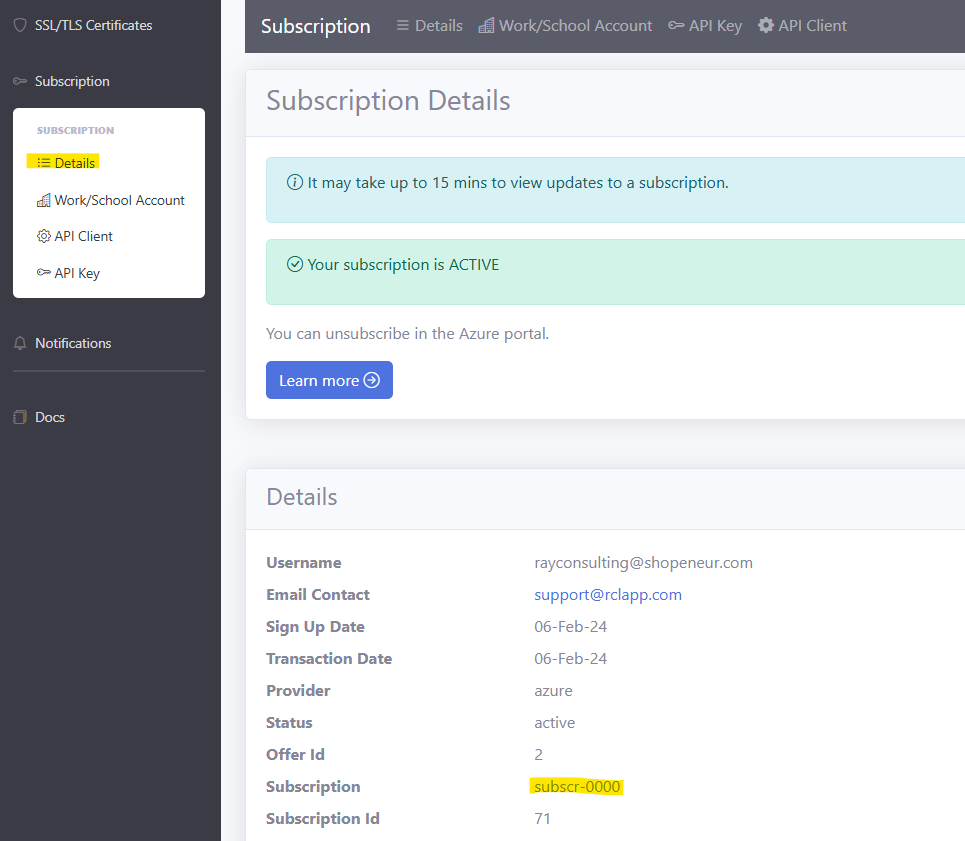Stand Alone Certificate
V8.0
In this section, you will learn how to order and create a Stand Alone Certificate (including SAN) using the RCL SSL API.
Prerequisites
Before you can use the API you must first :
- Obtain an API Key
- Create the CSR Information
Authorization
Obtain the API Key in the Subscription > API Key page in the RCL SSL Portal.
You must include the API Key in the authorization header of a request as a Bearer Token.
API Endpoint
The endpoint for making API requests is :
- https://rclapi.azure-api.net
Subscription
To make a request to the API, you must use your subscription. You can obtain the subscription value from the Subscription > Details page in the RCL SSL Portal.

Create a Certificate Order
You will first need to create a certificate order before you can create a Stand Alone certificate.
Send a POST request to :
/prod/v3/ssl/certificate/subscription/{your-subscription}/order/create
Include a Certificate object in the body of the request in jSON format. The following example shows the required fields for the object.
{
"certificateName" : "shopeneur.com",
"rootDomain" : "shopeneur.com",
"challengeType" : "dns",
"email" : "rcl@mail.com",
"password" : "password123",
"target": "Stand ALone",
"isSAN": false
}
Example Request
POST /prod/v3/ssl/certificate/subscription/subscr-0000/order/create HTTP/1.1
Host: rclapi.azure-api.net
Content-Type: application/json
Authorization: Bearer resdfre-t435-dkjh-5re6
Content-Length: 229
{
"certificateName" : "shopeneur.com",
"rootDomain" : "shopeneur.com",
"challengeType" : "dns",
"email" : "rcl@mail.com",
"password" : "password123",
"target": "Stand ALone",
"isSAN": false
}
Example Response
{
"certificateName": "shopeneur.com",
"rootDomain": "shopeneur.com",
"email": "rcl@mail.com",
"challengeType": "dns",
"orderUri": "https://acme-staging-v02.api.letsencrypt.org/acme/order/135518893/21014318564",
"target": "Stand ALone",
"subscriptionId": 71,
"password": "password123",
"tokens": [
{
"tokenName": "_acme-challenge",
"tokenValue": "RNUMtaXCdx0KGMneUmlP_DJzg7sew9e8FFOjsfoNNb8",
"challengeType": "DNS",
"domain": "shopeneur.com"
}
]
}
Create a Certificate
Once an order is created for a certificate, you will need to validate that you own or control the domain that you are requesting the certificate for.
To validate the http challenge you will need to place a file at the root of your website.
To validate the dns challenge you will need to add a TXT record in your DNS Registrar.
Once you complete the validation, you can now send a request to create a certificate.
Send a POST request to :
/prod/v3ssl/certificate/subscription/{your-subscription}/schedule/create
Include a Certificate object in the body of the request in jSON format. The following example shows the required fields for the object.
{
"certificateName" : "shopeneur.com",
"rootDomain" : "shopeneur.com",
"challengeType" : "dns",
"email" : "rcl@mail.com",
"password" : "password123",
"target": "Stand ALone",
"isSAN": false,
"orderUri": "https://acme-staging-v02.api.letsencrypt.org/acme/order/135518893/21014318564"
}
You must include the Order Uri in the Certificate object.
Example Request
POST /prod/v3/ssl/certificate/subscription/subscr-0000/schedule/create HTTP/1.1
Host: rclapi.azure-api.net
Content-Type: application/json
Authorization: Bearer resdfre-t435-dkjh-5re6
Content-Length: 296
{
"certificateName" : "shopeneur.com",
"rootDomain" : "shopeneur.com",
"challengeType" : "dns",
"email" : "rcl@mail.com",
"password" : "password123",
"target": "Stand ALone",
"isSAN": false,
"orderUri":"https://acme-staging-v02.api.letsencrypt.org/acme/order/135518893/20709585374"
}
After you make the post request, a 200 OK response will be returned.
Example Response
200 OK
Your certificate will be scheduled for creation at a later time. During this process, your domain will be validated based on the challenge you completed. Once the domain is validated, your certificate will be created.
You can access your new certificate using the Get Certificate API
Error Handling
Errors in the API will be returned as plain text in the body of a response, usually with a 400 Bad Request
Example Response
Certificate name is not defined.